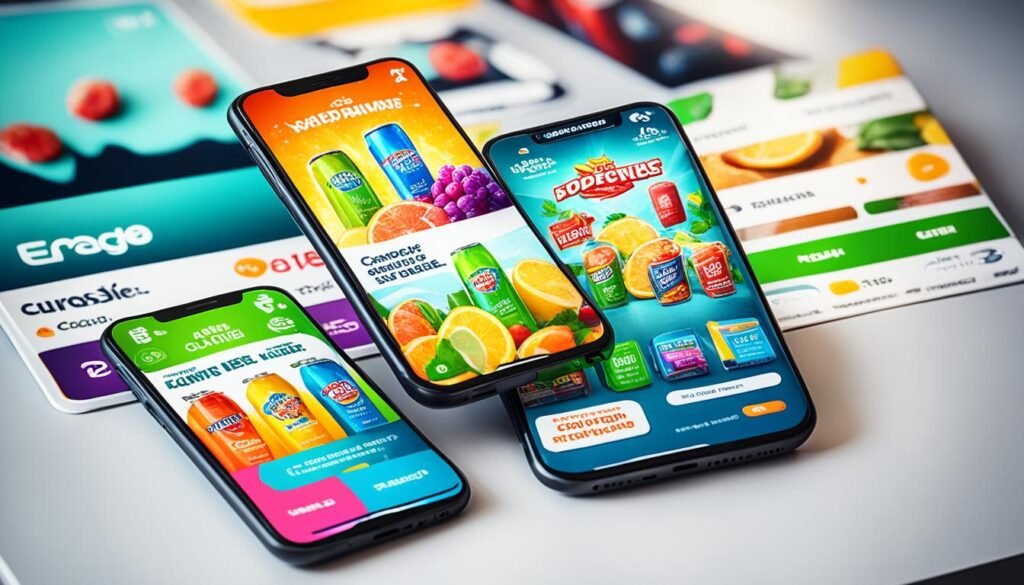Apps and websites have become an integral part of our daily lives. From social media platforms to e-commerce websites, these digital platforms offer a wealth of information, entertainment, and convenience. But have you ever wondered how these apps and websites generate revenue?
In this article, we will explore the various strategies that apps and websites employ to make money. We will delve into the importance of analyzing website traffic, optimizing user experience, and making data-driven decisions to drive traffic to their websites and generate revenue. Understanding these revenue generation methods can help businesses maximize their potential and increase their bottom line.
Key Takeaways:
- Apps and websites utilize various strategies to generate revenue.
- Analyzing website traffic and optimizing user experience are crucial for driving website traffic.
- Data-driven decisions play a key role in increasing conversion rates and generating revenue.
- Organic traffic is an essential component of revenue generation for apps and websites.
- By implementing effective strategies, businesses can enhance the user experience and ultimately increase revenue.
Understanding App Monetization
App monetization is the process of generating revenue from app users. It is a crucial aspect of revenue generation for app developers and can significantly impact app revenue. There are several methods that app developers can use to monetize their apps and increase their revenue.
In-App Ads
One popular method of app monetization is through in-app ads. In-app ads are advertisements that are displayed within the app. These ads can be in the form of banner ads, interstitial ads, rewarded video ads, or native ads. App developers can earn revenue by displaying these ads to their users. The revenue is generated based on ad impressions, clicks, or user actions.
In-app ads are a great way for app developers to generate revenue as they do not require users to make any additional purchases. It allows developers to offer their apps for free while still earning revenue through ad placements.
In-App Purchases
Another method of app monetization is through in-app purchases. In-app purchases allow app developers to offer additional content, features, or virtual items for purchase within the app. This gives users the option to enhance their app experience by unlocking premium features or making virtual purchases.
In-app purchases are particularly popular in gaming apps and e-commerce apps. Users can buy virtual items, subscriptions, or premium features, which not only enhances their app experience but also generates revenue for the app developers.
The Freemium Model
The freemium model is a combination of offering free features along with premium features for purchase. App developers can provide a basic version of the app with limited features for free, while offering additional features or content for a fee.
This model allows app developers to attract a larger user base with the free features, while generating revenue from users who choose to upgrade to the premium version. The freemium model provides users with the flexibility to choose the features they require and allows app developers to generate revenue from those who want additional functionality.
| App Monetization Methods | Revenue Generation |
|---|---|
| In-App Ads | Ad impressions, clicks, user actions |
| In-App Purchases | Purchases of virtual items, subscriptions, premium features |
| Freemium Model | Upgrade from free to premium version |
Premium Apps
In addition to in-app ads, in-app purchases, and the freemium model, some app developers choose to offer premium apps for a price. Premium apps require users to purchase the app upfront before they can access any features or content.
By offering a premium app, developers can generate revenue without the need for in-app ads or in-app purchases. This model is often preferred by developers who offer specialized or niche apps that provide unique value to users.
Understanding app monetization and utilizing different methods such as in-app ads, in-app purchases, freemium models, or premium app offerings can help app developers generate revenue and maximize their app’s potential.
Different Monetization Strategies for Websites

Websites have various options for monetizing their online presence and generating revenue. Let’s explore some of the most effective strategies in website monetization:
1. Display Advertising
Display advertising involves placing ads on a website to generate revenue. These ads can be in various formats, such as banners, pop-ups, or native ads. Website owners can partner with ad networks or use ad platforms like Google AdSense to monetize their website through display advertising.
2. Affiliate Marketing
Affiliate marketing is a popular website monetization strategy where website owners promote products or services of other businesses and earn a commission for each sale made through their referral. By partnering with affiliate programs and placing affiliate links on their website, website owners can generate revenue based on the referrals they drive.
3. Subscription Models
Subscription models allow websites to offer premium content or services in exchange for a recurring fee. This strategy is commonly used by news websites, online magazines, or platforms offering exclusive content. Implementing subscription models can provide a more consistent and predictable revenue stream for websites.
4. Sponsored Content and Sponsored Posts
Sponsored content involves collaborating with advertisers to publish content that promotes their products or services. This can include articles, blog posts, or videos created by the website owner or the advertiser. Sponsored posts are similar but are typically written by the advertiser and published on the website. Both strategies offer an opportunity for websites to generate revenue while providing valuable content to their audience.
5. Online Advertising Partnerships
Websites can enter into partnerships with other businesses to offer online advertising opportunities. This can involve banner ads, sponsored sections, or product placements. Online advertising partnerships provide a direct way for businesses to reach the target audience of the website and generate revenue through advertising fees.
Comparison of Different Monetization Strategies
| Monetization Strategy | Description | Advantages | Disadvantages |
|---|---|---|---|
| Display Advertising | Placing ads on the website | – Easy to implement – Potentially high revenue – Wide range of ad formats |
– Ad blockers can impact revenue – Ad placement may affect user experience |
| Affiliate Marketing | Promoting products or services for commissions | – Diverse range of products to promote – Performance-based revenue |
– Dependence on affiliate programs’ policies – Need to consistently drive referrals |
| Subscription Models | Offering premium content or services for a fee | – Predictable and recurring revenue – Opportunity for exclusive content |
– Potential resistance from users to pay for content – Need to continuously offer value to subscribers |
| Sponsored Content and Sponsored Posts | Collaborating with advertisers for promotional content | – Additional revenue stream – Opportunity to provide valuable content |
– Balancing user experience with promotional content – Maintaining authenticity and transparency |
| Online Advertising Partnerships | Entering into direct advertising agreements | – Direct control over ad placement – Targeted advertising opportunities |
– Requires active sales and negotiation – Dependence on advertisers’ budgets |
Each monetization strategy has its own advantages and considerations. Website owners can determine the most suitable approach based on their target audience, content type, and revenue goals.
The Potential of In-App Ads

In-app ads have emerged as a powerful monetization method for mobile apps, providing app developers with a significant source of app revenue. These ads operate through impression-based models, allowing developers to earn revenue based on ad impressions, clicks, or user actions. With various types of in-app ads available, including banner ads, interstitial ads, rewarded video ads, and native ads, developers have the opportunity to engage users with relevant advertising content while generating revenue.
In-app ads offer a win-win scenario, where developers can monetize their apps while users benefit from free access to valuable content.
One of the most common types of in-app ads is banner ads, which appear as small rectangular advertisements at the top or bottom of the app interface. These ads are lightweight and unobtrusive, allowing users to maintain a seamless app experience while still being exposed to promotional content. Banner ads can be an effective way to generate app revenue as they are often displayed throughout the app’s user interface, maximizing visibility and potential ad impressions.
Another popular type of in-app ad is interstitial ads, which are full-screen advertisements that appear at natural transition points within an app, such as between different levels in a game or when switching screens. These ads capture the user’s attention and provide an immersive ad experience, increasing the likelihood of ad engagement. Interstitial ads can be particularly effective for app developers looking to generate revenue through user actions, such as ad clicks or app installs.
Relevant to game apps and often used as a reward system, rewarded video ads offer users the option to watch a video advertisement in exchange for in-app rewards or premium content. This type of ad provides a value exchange for users and has proven to be highly engaging, leading to increased ad views and user interaction. Rewarded video ads not only generate app revenue but also enhance user satisfaction by offering additional benefits or incentives.
Native ads are another type of in-app ad that seamlessly blend into the app’s interface, matching the look and feel of the surrounding content. These ads are designed to be non-disruptive and highly contextual, providing a natural and integrated ad experience for users. Native ads are effective in capturing user attention and engagement, allowing developers to generate app revenue while maintaining a positive user experience.
Benefits of In-App Ads
- Increased App Revenue: In-app ads provide a reliable revenue stream for app developers, allowing them to monetize their apps without charging users for access.
- Enhanced User Experience: Well-designed in-app ads can blend seamlessly into the app interface, ensuring that users are not significantly disrupted or inconvenienced by ad placements.
- Targeted Advertising: In-app ads can be personalized and targeted based on user demographics, preferences, and behavior, ensuring that users are presented with relevant advertisements.
- Flexible Monetization Models: App developers have the freedom to choose between various monetization models, such as cost per impression (CPM), cost per click (CPC), or cost per action (CPA), depending on their app’s objectives and target audience.
Overall, in-app ads provide a lucrative opportunity for app developers to generate revenue while offering users free access to valuable content. By leveraging different types of in-app ads, developers can tailor their monetization approach to suit their app’s unique requirements and maximize their app revenue potential.
Maximizing Revenue with In-App Purchases

In-app purchases have become a popular and effective strategy for app monetization, particularly for game apps and e-commerce apps. By offering virtual items, subscription models, or premium features for purchase within the app, developers have the opportunity to generate revenue while enhancing the user experience.
One of the main advantages of in-app purchases is the ability to monetize app usage. Instead of relying solely on ads or paid downloads, developers can offer a range of enticing virtual items that users can buy to enhance their app experience. These virtual items can vary depending on the nature of the app – from power-ups and character skins in games to exclusive content or additional features in e-commerce or productivity apps.
Subscription models are another popular form of in-app purchases. By introducing subscription tiers with different benefits, app developers can provide additional value to users while ensuring a steady stream of recurring revenue. This model is particularly effective for apps that offer premium content, access to exclusive features, or regular updates.
Game apps, in particular, have successfully utilized in-app purchases to drive revenue. They offer various virtual items that gamers can purchase to enhance their gameplay, unlock levels, or gain an edge over their competitors. This monetization strategy allows game developers to tap into the growing market of avid gamers who are willing to invest in their gaming experience.
E-commerce apps also benefit from in-app purchases by providing users with a seamless shopping experience. By integrating secure payment methods within the app, users can easily make purchases without leaving the app, increasing the chances of completing a transaction. This convenience factor, coupled with personalized recommendations and exclusive deals, contributes to higher conversion rates and increased app revenue.
Overall, in-app purchases offer a viable and profitable avenue for app developers to monetize their creations. By strategically implementing virtual items, subscription models, and other in-app purchase options, developers can generate revenue while delivering value to their users. Maximizing app revenue requires understanding the target audience, creating compelling purchase opportunities, and continuously refining the monetization strategy based on user feedback and data-driven insights.
Benefits of In-App Purchases:
- Monetize app usage and engagement
- Enhance user experience by offering valuable virtual items
- Create a steady stream of recurring revenue through subscriptions
- Tap into the growing market of avid gamers
- Drive higher conversion rates and increase app revenue for e-commerce apps
Exploring the Freemium Model

The freemium model is a popular app monetization strategy that allows app developers to attract a larger user base by offering both free and premium features. This model strikes a balance between user acquisition and app revenue generation through subscription models or in-app purchases for premium features.
With the freemium model, users can access basic functionalities and features of the app for free. This approach is beneficial for attracting a wide range of users who may be hesitant to pay upfront or commit to a full premium version. By providing valuable free features, app developers can capture the attention of potential users and increase their chances of adoption.
However, the freemium model also offers premium features that users can access through paid subscriptions or in-app purchases. These premium features enhance the user experience and provide additional value beyond what is offered in the free version. By offering exclusive features or content, app developers can incentivize users to upgrade to the premium version, generating app revenue.
The subscription model is a common approach within the freemium model. Users can subscribe to a recurring payment plan to unlock premium features, content, or services. Subscriptions can be offered on a monthly, yearly, or even lifetime basis, depending on the app’s pricing strategy. This recurring revenue stream can provide a stable source of app revenue and ensure a continuous flow of income.
In addition to subscriptions, in-app purchases are another way to monetize the freemium model. App developers can offer individual purchases for specific premium features or virtual items within the app. This allows users to customize their app experience by purchasing only the features they find most valuable or engaging. In-app purchases can be particularly effective in gaming apps, where users can buy power-ups, cosmetic upgrades, or additional levels.
Benefits of the Freemium Model
The freemium model offers several advantages for app developers looking to monetize their apps:
- Expanded user base: By offering free features, the freemium model attracts a larger user base, increasing the app’s visibility and potential for growth.
- User engagement: Free features allow users to explore and engage with the app, increasing their familiarity and attachment to it.
- Increased conversion rates: Users who find value in the free features are more likely to upgrade to the premium version, resulting in higher conversion rates.
- Flexible revenue streams: The freemium model allows app developers to diversify their revenue streams through both subscriptions and in-app purchases.
- Continuous monetization: With recurring subscriptions, app developers can ensure a continuous flow of app revenue and maintain a sustainable business model.
By leveraging the freemium model, app developers can strike a balance between user acquisition and app revenue generation. This model offers users the flexibility to access free features while providing opportunities to upgrade and unlock additional premium functionality through subscriptions or in-app purchases.
| Free Features | Premium Features | Monetization Method |
|---|---|---|
| Basic functionality of the app | Advanced features and functionalities | Subscription models or in-app purchases |
| Limited content or access | Exclusive content or extended access | Subscription models or in-app purchases |
| Ad-supported version of the app | Ad-free experience | Subscription models or in-app purchases |
Leveraging Website Advertising

Website advertising is a common strategy for website monetization, allowing website owners to generate revenue through online advertising partnerships. By offering ad space on their websites, businesses can optimize their website revenue and overall profitability.
One of the key components of website advertising is the placement of display ads. These ads are visually engaging and can be strategically positioned on a website to capture the attention of visitors. Display ads come in various formats, including banners, pop-ups, or sidebars, and can effectively promote products, services, or events.
A popular form of website advertising is native advertising. Native ads seamlessly blend into the website’s design and content, creating a more natural and less disruptive advertising experience for users. These ads often appear as sponsored articles or recommended content, providing valuable information while promoting relevant products or services.
Sponsored content is another effective strategy for website advertising. It involves partnering with brands to create content that aligns with the website’s niche and interests its audience. Sponsored content can take the form of articles, videos, or infographics, offering informative and valuable content while subtly integrating promotional messages.
Benefits of Website Advertising
Website advertising offers several benefits for both website owners and advertisers. Firstly, it provides website owners with a consistent source of revenue. By leveraging their website’s traffic, they can attract advertisers and charge fees for displaying ads or featuring sponsored content, thereby monetizing their online presence.
For advertisers, website advertising allows them to reach a targeted audience. By selecting websites that align with their target market, they can effectively promote their products or services to potential customers who are more likely to engage with the ads. This targeted approach can lead to higher conversion rates and increased revenue for advertisers.
Moreover, website advertising enhances the overall user experience. When done thoughtfully, ads can be relevant, non-intrusive, and even complementary to the website’s content. Display ads, native advertising, and sponsored content can provide users with useful information or personalized recommendations, creating a win-win situation for both users and advertisers.
In conclusion, website advertising is a powerful tool for website monetization and revenue generation. By strategically placing display ads, embracing native ads, and leveraging sponsored content, website owners can effectively monetize their traffic and attract advertisers. This mutually beneficial relationship between website owners and advertisers ultimately results in increased website revenue and improved user experience.
Making Data-Driven Decisions

When it comes to optimizing revenue generation for apps and websites, data-driven decisions are key. By leveraging website analytics and analyzing user behavior and conversion rates, app developers and website owners can unlock valuable insights that inform their revenue generation strategies. Making data-driven decisions allows businesses to drive website traffic, increase conversion rates, and maximize revenue potential.
Website analytics provide a wealth of information about how users interact with a website. By examining metrics such as page views, bounce rates, and time spent on page, businesses can gain a deeper understanding of user behavior and identify areas for improvement. This data-driven approach empowers app developers and website owners to fine-tune their websites and optimize user experience, ultimately increasing the likelihood of generating revenue.
“Data-driven decisions are like headlights on a dark road. They illuminate the path forward, allowing businesses to navigate the digital landscape with confidence and clarity.”
Conversion optimization is another critical aspect of revenue generation. By tracking conversion rates and analyzing user journeys, businesses can identify potential bottlenecks or areas where users are dropping off. Armed with this knowledge, app developers and website owners can make data-driven decisions to address these issues and improve the conversion process, ultimately increasing the likelihood of generating revenue.
Website optimization is yet another area where data-driven decisions shine. By leveraging website analytics and monitoring user behavior, businesses can identify aspects of their websites that may be hindering revenue generation. Whether it’s slow loading times, confusing navigation, or poorly optimized landing pages, data-driven decisions can guide app developers and website owners towards making the necessary optimizations to drive revenue.
Ultimately, the power of data-driven decisions lies in their ability to inform revenue generation strategies. By utilizing website analytics, understanding user behavior, optimizing conversion rates, and fine-tuning website performance, businesses can maximize their revenue potential. The integration of data-driven decision making ensures that apps and websites are constantly evolving and adapting to the needs and preferences of their users, ultimately leading to increased revenue generation.
Benefits of Making Data-Driven Decisions:
- Optimizing revenue generation through informed insights
- Improving user experience and satisfaction
- Identifying and addressing conversion bottlenecks
- Enhancing website performance for better revenue generation
- Driving website traffic and increasing user engagement
By prioritizing data-driven decisions and utilizing website analytics, businesses can take their revenue generation efforts to the next level. The insights gained from data analysis not only inform strategic decision-making but also contribute to the overall success and growth of apps and websites.
Also Read : How Can I Monetize My Blog or Website?
Conclusion
App and website monetization play a crucial role in revenue generation for businesses. By implementing effective strategies such as in-app ads, in-app purchases, freemium models, and website advertising, businesses can maximize their revenue potential. However, it is equally important to make data-driven decisions to optimize these strategies and drive revenue even further.
Data-driven decisions are essential for app developers and website owners to analyze website traffic, user behavior, and conversion rates. By utilizing website analytics, businesses can identify areas for improvement and make informed decisions to drive website traffic, enhance user experience, and increase revenue. This approach allows businesses to make strategic changes based on real-time insights and make the most out of their monetization efforts.
In conclusion, by understanding the importance of app and website monetization, businesses can unlock their revenue potential. By maximizing revenue through strategic approaches, such as in-app ads, in-app purchases, freemium models, and website advertising, and making data-driven decisions, businesses can drive traffic, improve user experience, and ultimately boost their bottom line.
FAQs
How do apps and websites make money?
Apps and websites generate revenue through various methods such as analyzing website traffic, optimizing user experience, driving website traffic through organic means, and making data-driven decisions to increase conversion rates and generate revenue.
What is app monetization?
App monetization refers to the process of generating revenue from app users. This can be achieved through different methods such as in-app ads, in-app purchases, freemium models, and premium apps. App monetization is a crucial aspect of revenue generation for app developers and can significantly impact app revenue.
How can websites monetize their online presence?
Websites can monetize their online presence through various strategies, including display advertising, affiliate marketing, subscription models, sponsored content, and sponsored posts. These strategies involve generating revenue through online advertising and partnerships, providing valuable content to attract and retain visitors, and creating opportunities for businesses to promote their products or services.
What are in-app ads?
In-app ads are a popular monetization method for apps, generating revenue through impression-based models. Different types of in-app ads, such as banner ads, interstitial ads, rewarded video ads, and native ads, offer opportunities for app developers to earn revenue based on ad impressions, clicks, or user actions. In-app ads can be an effective way to generate app revenue and engage users with relevant advertising content.
How do in-app purchases generate revenue?
In-app purchases are a popular monetization strategy for app developers, especially in game apps and e-commerce apps. By offering virtual items, subscriptions, or premium features for purchase within the app, developers can generate revenue and enhance the user experience. In-app purchases provide an opportunity to monetize app usage and increase app revenue.
What is the freemium model?
The freemium model is a popular app monetization strategy that offers both free and premium features to users. This model allows app developers to attract a larger user base with free features while generating revenue through subscription models or in-app purchases for premium features. The freemium model can be an effective way to balance user acquisition and app revenue.
How can websites leverage advertising?
Website advertising is a common strategy for website monetization, involving the placement of display ads, native advertising, and sponsored content. By offering ad space on their websites, website owners can generate revenue from online advertising partnerships. Website advertising is an effective strategy to monetize website traffic and increase revenue.
How important are data-driven decisions?
Data-driven decisions play a crucial role in optimizing revenue generation for apps and websites. By analyzing website traffic, user behavior, and conversion rates through website analytics, app developers and website owners can identify areas for improvement and make data-driven decisions to optimize their revenue generation strategies. Data-driven decisions are essential for driving website traffic, increasing conversion rates, and maximizing revenue potential.
Why is revenue generation important for apps and websites?
App and website monetization are important factors in revenue generation for businesses. By implementing effective strategies such as in-app ads, in-app purchases, freemium models, website advertising, and making data-driven decisions, apps and websites can maximize their revenue potential. Understanding the importance of monetization and utilizing various strategies can help businesses drive traffic, enhance user experience, and increase revenue.
Source Links
- https://www.uptech.team/blog/how-do-free-apps-make-money
- https://kinsta.com/blog/how-do-apps-make-money/
- https://appetiser.com.au/blog/how-do-free-apps-make-money/





